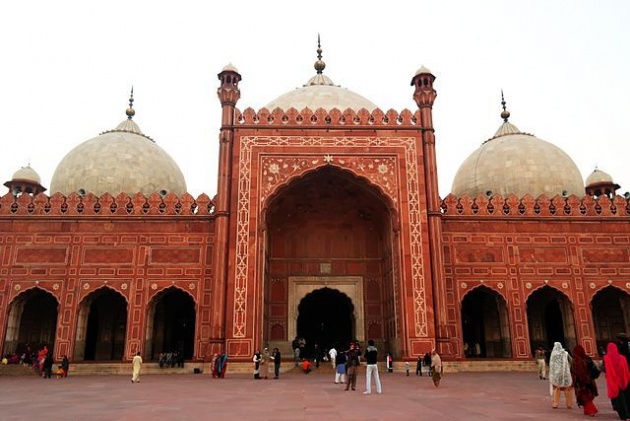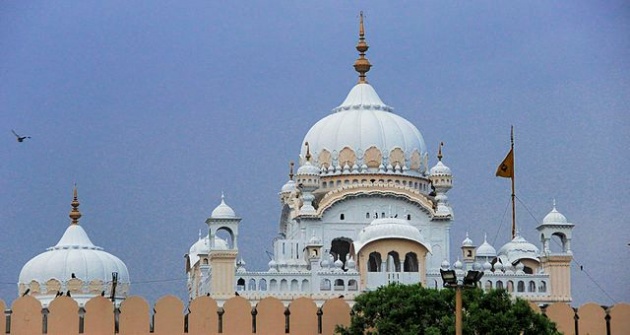Lahore (/ləˈhɔər/) (Punjabi: لہور, Urdu: لاہور) is the capital city of the Pakistani province of Punjab. It is the second largest and most populous city in Pakistan, after Karachi, and the 32nd most populous urban city in the world.[2] The city is located in the north east part of Punjab province, near the border with India. Lahore is ranked as a Gamma+ world city,[4] and is one of Pakistan's wealthiest cities with an estimated total nominal GDP of $58.14 billion.

Country Pakistan
Province Flag of Punjab.svg Punjab
City District Government 11 September 2008
City Council Lahore
Towns 10
Government
• Type City District
• District Administrator Captain (R) Muhammad Usman Younis
• District Coordination Officer Captain (R) Muhammad Usman Younis
• Capital City Police Chief Captain (R) Amin Venus
Area[1]
• Total 1,772 km2 (684 sq mi)
Elevation 217 m (712 ft)
Population (2016)[2]
• Total 10,355,000
Lahore Urban agglomeration
Demonym(s) Lahori
Time zone PKT (UTC+5)
Postal code 54000
Dialling code 042[3]
HDI 0.806 Increase
HDI Category Very High
Lahore Cantonment is a legally separate military-administered settlement.
Mughal era
Badshahi Mosque, Lahore.

In the early 16th century, Babur, a Timurid descendant of Timur and Genghis Khan fromFergana Valley (modern day Uzbekistan), swept across the Khyber Pass and founded the Mughal Empire, covering modern day Afghanistan, Pakistan, and India.[40] The Mughals were descended from Central Asian Turco-Mongols.
Lahore reached the zenith of its glory during the Mughal rule from 1524 to 1752. Many of Lahore's most renowned sites date from this period, and include the Badshahi Mosque, Wazir Khan Mosque, the Lahore Fort, and the Shalimar Gardens.[39]
Humayun, his son married Hamida Banu Begum in Lahore while fleeing to Persia. It was also the headquarters of Mughal rule during Akbar between 1584 and 1598. Thus along with Agraand Delhi, it became an "alternate seat of imperial court". Akbar also held discussions with Portuguese missionaries in the city. Abul Fazl, his court historian calls it a "a great city in Bari Doab, in magnificance and populousness it has few equals".
The Mughal period in Lahore was interrupted with Nader Shah's brief conquest in early 1739.[42] Before leaving Delhi later that same year, he gave it back to the Mughal EmperorMuhammad Shah, as with all other Mughal territories to the east of the Indus which he had overrun.[43] Ahmed Shah Abdali took the city between 1747 and 1758, the founder of the Afghan Durrani Empire.
In 1758, the Maratha Empire's general Raghunathrao conquered Lahore, Attock andPeshawar, and drove out Timur Shah Durrani who was the son and viceroy of Ahmad Shah Abdali.[44] In 1761, following the victory at the Third Battle of Panipat between the Afghan Durrani and the Maratha Empire, Ahmad Shah Abdali captured Lahore from the Marathas.[45]Afghan rule continued until Lahore was captured by the Sikhs in 1799.
Sikh era

During the late 18th century when the Mughal Empire was in decline, frequent invasions by the Durrani Empire and the Maratha Empire led to a power vacuum in Punjab. The Sikh Mislscame into conflict with the Durrani Empire, with Bhangi Misl eventually capturing Lahore. AfterZaman Shah invaded Punjab in 1799, the region was further destabilized, allowing Ranjit Singh to consolidate his position in the aftermath of the invasion. Singh entered into battle with Zaman, and was able to seize control of the region after a series of battles with theBhangi Misl and their allies.[46] After capturing the Lahore, the Sikh army immediately began plundering the city until their actions were reigned in by Ranjit Singh.[47] Thereafter, Lahore then served as the capital city of the Sikh Empire.
While much of Lahore's Mughal era fabric lay in ruins by the end of 18th century, the Sikh rulers plundered several of Lahore's most precious Mughal monuments, and stripped the white marble from several monuments to send to different parts of the Sikh Empire.[48]Monuments plundered of their marble include the Tomb of Asif Khan and the Tomb of Nur Jahan.[49] The Shalimar Gardens were plundered of much of its marble which was transported to decorated the Ram Bagh in nearby Amritsar, while the gardens' costly agate gate was stripped and sold by Lehna Singh Majithia, one of the governors of Lahore during Sikh rule.Ranjit Singh's army also desecrated the most important Mughal mosques in Lahore. TheBadshahi Mosque was converted it into an ammunition depot and a stable for Ranjit Singh's horses.The Golden Mosque in the Walled City of Lahore was also converted to agurdwara for a period of time,[52] while the Mosque of Mariyam Zamani Begum was repurposed into a gunpowder factory.[53] Ranjit Singh's son, Sher Singh, continued the pattern of the desecrating Mughal mosques by mounting weaponry to Badshahi Mosque's minarets in order to target his political opponents in the nearby Lahore Fort, destroying the fort's historic Diwan-e-Aam.
Rebuilding efforts under the Sikh Empire were influenced by Mughal practices. Ranjit Singh himself moved into the Mughal palace at the Lahore Fort and re-purposed it for his own use in governing the Sikh Empire.[55] By 1812 Singh had mostly refurbished the city's defences by adding a second circuit of outer walls surrounding Akbar's original walls, with the two separated by a moat. Singh also partially restored Shah Jahan's decaying gardens at Shalimar.[citation needed] Later British maps of the area surrounding Lahore dating from the mid-19th century show many walled private gardens bearing the names of prominent Sikh nobles - a pattern of patronage which was inherited from the Mughals. The Sikh court continued to endow religious architecture in the city, including a number of Sikh gurdwaras, Hindu temples,[56][57] and mosques.[citation needed] After the conclusion of two Anglo-Sikh wars, theBritish East India Company first seized control of Lahore in 1846, and the remainder Punjab by 1849.
For more in next post



